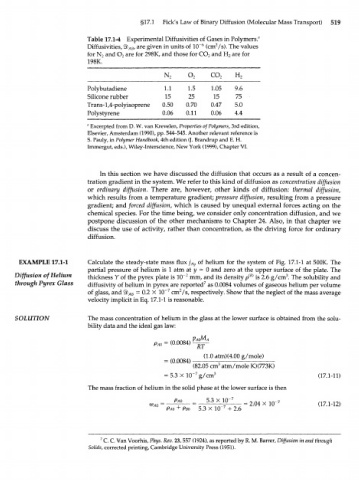Page 539 - Bird R.B. Transport phenomena
P. 539
§17.1 Fick's Law of Binary Diffusion (Molecular Mass Transport) 519
Table 17.1-4 Experimental Diffusivities of Gases in Polymers."
2
6
Diffusivities, ЯЬ , are given in units of 10~ (cm /s). The values
АВ
for N and O are for 298K, and those for CO and H are for
2
2
2
2
198K.
O, CO,
Polybutadiene 1.1 1.5 1.05 9.6
Silicone rubber 15 25 15 75
Trans-1,4-polyisoprene 0.50 0.70 0.47 5.0
Polystyrene 0.06 0.11 0.06 4.4
0
Excerpted from D. W. van Krevelen, Properties of Polymers, 3rd edition,
Elsevier, Amsterdam (1990), pp. 544-545. Another relevant reference is
S. Pauly, in Polymer Handbook, 4th edition (J. Brandrup and E. H.
Immergut, eds.), Wiley-Interscience, New York (1999), Chapter VI.
In this section we have discussed the diffusion that occurs as a result of a concen-
tration gradient in the system. We refer to this kind of diffusion as concentration diffusion
or ordinary diffusion. There are, however, other kinds of diffusion: thermal diffusion,
which results from a temperature gradient; pressure diffusion, resulting from a pressure
gradient; and forced diffusion, which is caused by unequal external forces acting on the
chemical species. For the time being, we consider only concentration diffusion, and we
postpone discussion of the other mechanisms to Chapter 24. Also, in that chapter we
discuss the use of activity, rather than concentration, as the driving force for ordinary
diffusion.
EXAMPLE 17.1-1 Calculate the steady-state mass flux j A y of helium for the system of Fig. 17.1-1 at 500K. The
partial pressure of helium is 1 atm at у = 0 and zero at the upper surface of the plate. The
Diffusion of Helium thickness У of the pyrex plate is 10~ mm, and its density p is 2.6 g/cm . The solubility and
2
(B)
3
through Pyrex Glass diffusivity of helium in pyrex are reported as 0.0084 volumes of gaseous helium per volume
7
7
2
of glass, and ЯЬ = 0.2 X 10" cm /s, respectively. Show that the neglect of the mass average
АВ
velocity implicit in Eq. 17.1-1 is reasonable.
SOLUTION The mass concentration of helium in the glass at the lower surface is obtained from the solu-
bility data and the ideal gas law:
р = (0.0084) -
RT
А0
(1.0dtm)(4.00g/mole)
= (0.0084) -
3
(82.05 cm atm/mole K)(773K)
= 5.3 X10' 7 g/cm 3 (17.1-11)
The mass fraction of helium in the solid phase at the lower surface is then
PAO 5.3 X 10~ 7 = 2.04 X 10" (17.1-12)
PAO + PBO 5.3 X 10~ 7 + 2.6
7 С. С Van Voorhis, Phys. Rev. 23, 557 (1924), as reported by R. M. Barrer, Diffusion in and through
Solids, corrected printing, Cambridge University Press (1951).

